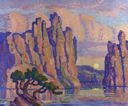Sven Birger Sandzen does not have an image.
Sven Birger Sandzen
(Blidsberg, Sweden, 1871 - 1954, Lindsborg, Kansas)
Birger Sandzen was born in Sweden in 1871, and died in Lindsborg, Kansas, in 1954. Sandzen was best known as an impressionist landscape painter of the American Rockies, but he was also a graphic artist and, for over 50 years, a university professor. The son of a Lutheran minister, Sandzen received all of his art education in Europe. He immigrated to Kansas in 1894, at the age of 23, with an appointment to teach modern languages, painting, and aesthetics at Bethany College in Lindsborg. For the next 52 years, he devoted himself to teaching, not only at the college but also across the prairie in small towns and villages, leaving behind generations of men and women with an appreciation of the visual arts. Sandzen was a professional artist with little interest in making a national reputation for himself. He was happy influencing no more than the small, midwestern communities. In 1928, Sandzen came to Utah at the invitation of Calvin Fletcher of the Utah State Agricultural College (later known as Utah State University) in Logan. While in Utah, Sandzen was also invited to be a visiting professor at the Brigham Young University in Provo for the summer of 1928. He later taught in Logan, Utah, during the summers of 1929 and 1930. The heightened color and intensity of emotion which Sandzen's paintings display are not a reflection of the calm, methodical manner in which they were executed. His philosophy, according to Sandzen's daughter, is best described as "controlled exuberance for life." He was also called a Poetic Expres-sionist in reference to his vividly colorful figures and landscapes. He deeply impressed many Utah artists, becoming the dominant artistic force during the late 1920's. Birger Sandzen was attracted to Utah by the enthusiastic reception three of his paintings had received at the Springville High School Art Gallery's "Spring Salon" in 1928. In early 1928, he was in southeastern Utah where he painted Moonrise in the Canyon, Moab, Utah. When he exhibited the oil at the 1928 Salon, it was purchased by the Junior class for the Gallery. Sandzen's influence on Utah art of the period was immeasurable. His thick impasto, raw color, and regionalist scenery captured the imagination of Utah artists such as Phillip H. Barkdull, Louise Richards Farnsworth, Mabel Frazer, LeRoy Gardner, and Calvin Fletcher. Sandzen painted in a Neo-Impressionistic or Fauvist style very unlike the restrained, conservative art of Utah at the time. Fauvism, from the French "fauve," meaning "wild beast," is a style using pure, brilliant color combined with rough brushstrokes and thick outlines. The Fauves strove to liberate color; light and shadows were believed to be equally luminous, resulting in works that contrast hues rather than tones. Sandzen's expressive, energetic style was short-lived because the onset of the Great Depression caused a more somber spirit to pervade the art of the period.
(Blidsberg, Sweden, 1871 - 1954, Lindsborg, Kansas)
Birger Sandzen was born in Sweden in 1871, and died in Lindsborg, Kansas, in 1954. Sandzen was best known as an impressionist landscape painter of the American Rockies, but he was also a graphic artist and, for over 50 years, a university professor. The son of a Lutheran minister, Sandzen received all of his art education in Europe. He immigrated to Kansas in 1894, at the age of 23, with an appointment to teach modern languages, painting, and aesthetics at Bethany College in Lindsborg. For the next 52 years, he devoted himself to teaching, not only at the college but also across the prairie in small towns and villages, leaving behind generations of men and women with an appreciation of the visual arts. Sandzen was a professional artist with little interest in making a national reputation for himself. He was happy influencing no more than the small, midwestern communities. In 1928, Sandzen came to Utah at the invitation of Calvin Fletcher of the Utah State Agricultural College (later known as Utah State University) in Logan. While in Utah, Sandzen was also invited to be a visiting professor at the Brigham Young University in Provo for the summer of 1928. He later taught in Logan, Utah, during the summers of 1929 and 1930. The heightened color and intensity of emotion which Sandzen's paintings display are not a reflection of the calm, methodical manner in which they were executed. His philosophy, according to Sandzen's daughter, is best described as "controlled exuberance for life." He was also called a Poetic Expres-sionist in reference to his vividly colorful figures and landscapes. He deeply impressed many Utah artists, becoming the dominant artistic force during the late 1920's. Birger Sandzen was attracted to Utah by the enthusiastic reception three of his paintings had received at the Springville High School Art Gallery's "Spring Salon" in 1928. In early 1928, he was in southeastern Utah where he painted Moonrise in the Canyon, Moab, Utah. When he exhibited the oil at the 1928 Salon, it was purchased by the Junior class for the Gallery. Sandzen's influence on Utah art of the period was immeasurable. His thick impasto, raw color, and regionalist scenery captured the imagination of Utah artists such as Phillip H. Barkdull, Louise Richards Farnsworth, Mabel Frazer, LeRoy Gardner, and Calvin Fletcher. Sandzen painted in a Neo-Impressionistic or Fauvist style very unlike the restrained, conservative art of Utah at the time. Fauvism, from the French "fauve," meaning "wild beast," is a style using pure, brilliant color combined with rough brushstrokes and thick outlines. The Fauves strove to liberate color; light and shadows were believed to be equally luminous, resulting in works that contrast hues rather than tones. Sandzen's expressive, energetic style was short-lived because the onset of the Great Depression caused a more somber spirit to pervade the art of the period.
Artist Objects
